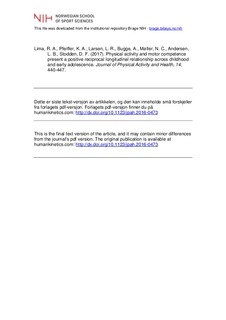Physical activity and motor competence present a positive reciprocal longitudinal relationship across childhood and early adolescence
Lima, Rodrigo Antunes; Pfeiffer, Karin Allor; Larsen, Lisbeth Runge; Bugge, Anna; Møller, Niels Christian; Andersen, Lars Bo; Stodden, David F.
Journal article, Peer reviewed
Accepted version
Permanent lenke
http://hdl.handle.net/11250/2470643Utgivelsesdato
2017-06Metadata
Vis full innførselSamlinger
- Artikler / Articles [2119]
Sammendrag
Background: The current study evaluated the reciprocal longitudinal relationship between physical activity (PA) and motor competence (MC) and the potential mediation of cardiorespiratory endurance across 7 years. Methods: This was a 7-year longitudinal study, the Copenhagen School Child Intervention Study (CoSCIS), with 3 measuring points [mean ages (in years) and respective sample size: 6.75 ± 0.37, n = 696; 9.59 ± 1.07, n = 617; 13.35 ± 0.34, n = 513]. PA was assessed using accelerometers. MC was evaluated by the Körperkoordinationstest für Kinder (KTK) test battery. Cardiorespiratory fitness (VO2peak) was evaluated using a continuous running protocol until exhaustion. Structural equation modeling was performed to evaluate the longitudinal associations. Results: Vigorous PA (VPA) and MC presented reciprocal longitudinal association during the 7-year follow-up (VPA → MC; β = 0.18; 95% CI: 0.10, 0.26; MC → VPA; β = 0.14; 95% CI: 0.08, 0.21). In addition, VO2peak mediated the relationship in both directions (VPA → MC; β = 0.09; 95% CI: 0.06, 0.12; MC → VPA; β = 0.06; 95% CI: 0.03, 0.09). Conclusions: PA and MC presented a positive reciprocal relationship across childhood through early adolescence and VO2peak mediated the association in both directions. Interventions targeting to increase PA in children and adolescents should also address the development of MC skills because of the clear positive feedback loop between PA and MC.
Beskrivelse
I Brage finner du siste tekst-versjon av artikkelen, og den kan inneholde ubetydelige forskjeller fra forlagets pdf-versjon. Forlagets pdf-versjon finner du på humankinetics.com / In Brage you'll find the final text version of the article, and it may contain insignificant differences from the journal's pdf version. The definitive version is available at humankinetics.com
